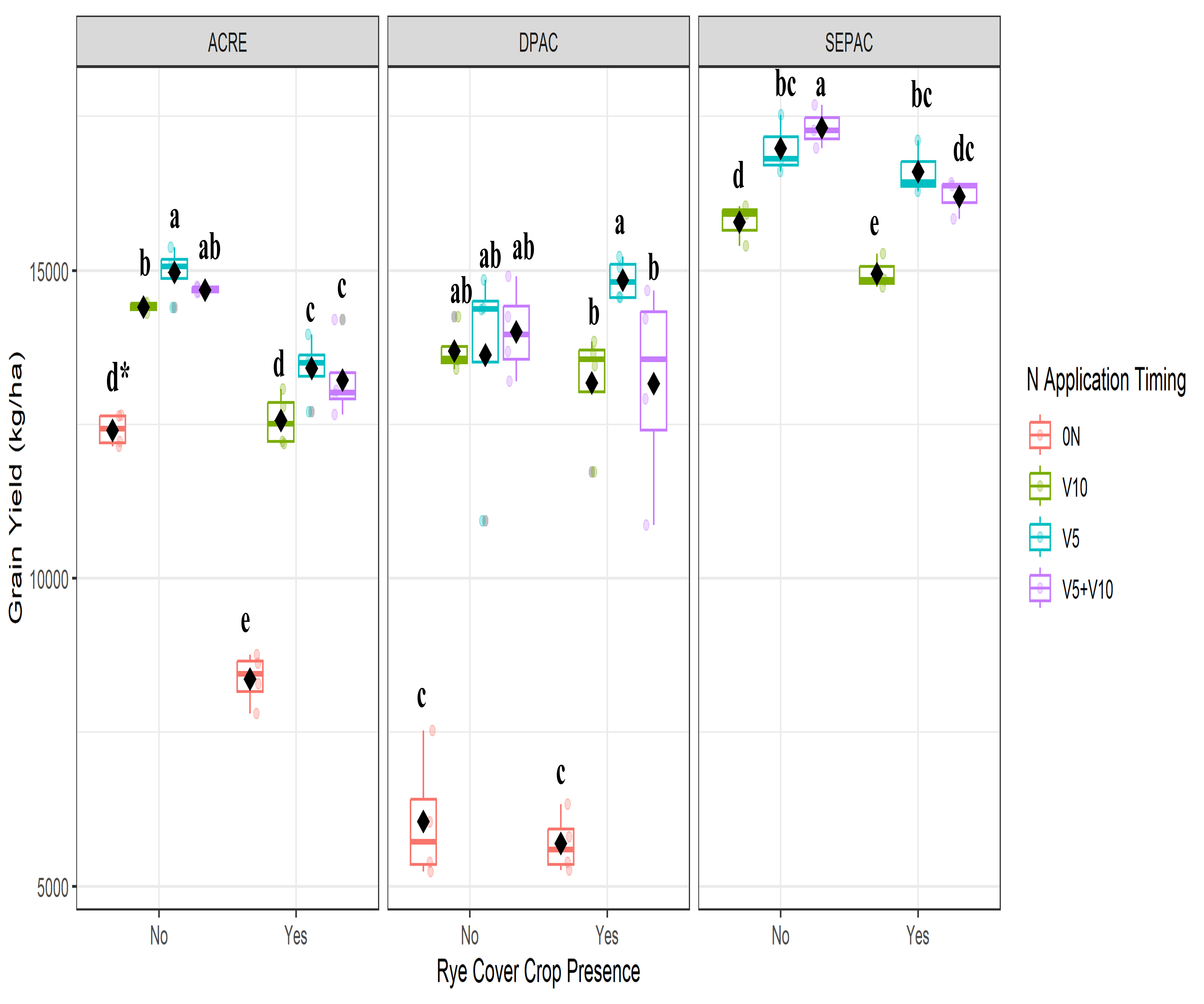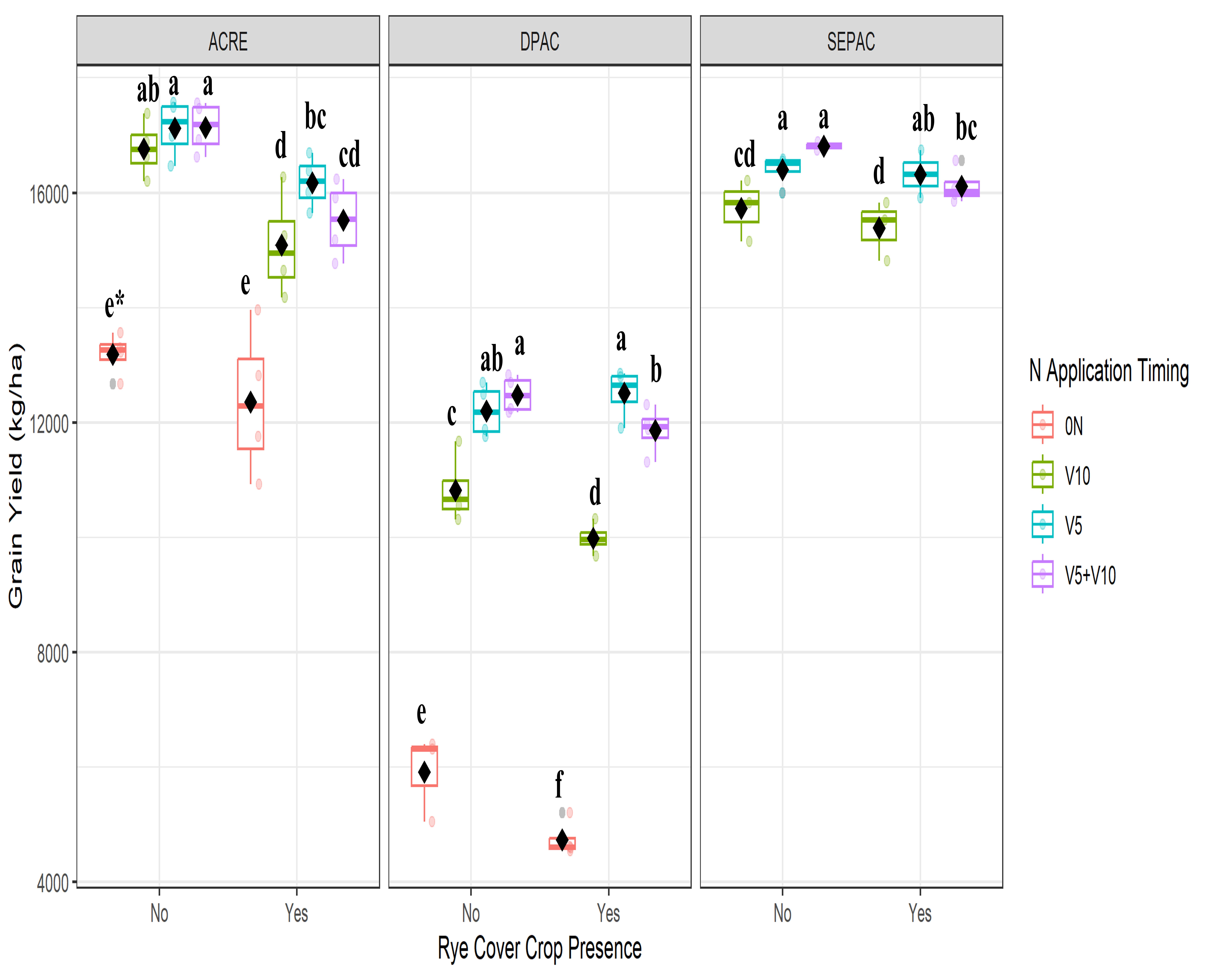Final report for GNC22-355
Project Information
Previous research has documented rye cover crop (RCC) benefits on weed suppression, erosion control, water quality improvement, and organic matter contributions. Yet, RCC adoption is often low prior to corn, suggesting further research and extension needs to be conducted to develop and disseminate corn management recommendations following a RCC. Therefore, the proposed objective of this study is to evaluate corn growth, yield, and nutrient uptake responses to different N fertilizer application timings following a RCC using multiple field-scale research environments. The outcomes of this study include: development of corn N fertilizer timing recommendations following a RCC, development of resources to train and disseminate educational information to farmers and crop consultants across the North Central SARE region, and reduced RCC hesitancy prior to corn. The treatments within this study include: RCC and no cover crop and N fertilizer applied at a rate of 44 kg N ha-1 in a 2 inches to the side, 2 inches below the seed (2x2) starter at planting + remaining N fertilizer sidedressed at the V5 growth stage, a 2x2 starter + remaining N fertilizer sidedressed between the corn rows at the V10 growth stage, and a 2x2 starter + V5 sidedress + V10 sidedress. This study will be conducted across entire farm fields using commercial equipment at three locations across Indiana to enhance result applicability to North Central region farmers. Data collection will include: soil N analysis throughout the corn growing season, RCC total biomass, carbon and N analysis, corn stand assessment, corn plant biomass and N uptake analysis at growth stages R1 and R6, and corn ear samples for grain yield component examination. Furthermore, NDVI imagery will be collected every two weeks using an unmanned aerial vehicle (UAV) to assess spatial plant responses regarding treatment applications. By developing N fertilizer timing recommendations following a RCC, farmers will be able to adopt more efficient fertilizer management practices, optimize corn production following a RCC and be more likely to implement RCC prior to corn planting. Results from this study will provide direct, applicable information to North Central SARE region farmers to reduce corn yield losses following a RCC, RCC hesitancy, and allow a RCC to be implemented consecutively in farmers cropping rotations.
Since 2012, cover crop use in the Midwest prior to corn production has been steadily increasing. However, adoption often remains low compared to total corn production acres. Low adoption is often driven by a lack of knowledge regarding proper agronomic management of corn within a cover crop system and producer hesitancy caused by reduced crop yields. Rye cover crop use is popular and is often the only cover crop choice for farmers due to germination success, biomass production, and survival. A RCC can provide environmental benefits such as reduced soil erosion, scavenging of excess N, and suppression of weeds. However, limited knowledge has been gathered on proper agronomic management techniques specific to corn following a RCC. Developing knowledge and skills on appropriate agronomic management of corn following a RCC could help change the attitude of RCC hesitant farmers and lead to an increased adoption of this sustainable practice. Therefore, the outcomes of this study are to identify N fertilizer application timing methods on a field scale using commercial farm equipment that will help reduce corn N stress and yield loss following a RCC. In addition, educational and extension materials will be developed and presented to help train, improve overall knowledge, and influence producer behavior. Behavioral changes will be tracked using extension meeting and field training surveys and scheduled consultations with a farmer advisory committee. The accomplishment of our outcomes will help educate farmers, certified crop advisors, government agency officers, and agricultural professionals in the North-Central Region and reduce RCC hesitancy.
Research
Field-scale research trials were conducted at three locations in Indiana over 2022 and 2023, namely the Purdue Agriculture Center for Research and Education (ACRE) in West Lafayette, Southeast Purdue Agricultural Center (SEPAC) in Jennings County, and Davis Purdue Agricultural Center (DPAC) in Randolph County. These trials aimed to study the impact of rye cover crops (RCC) and nitrogen (N) fertilizer application timing on corn production. All locations utilized no-till practices, rainfed conditions, and followed a corn-soybean rotation.
Experimental procedures involved a factorial, randomized complete block design with varying replications across locations. RCC treatments included fall drill-seeding at 50 kg/ha or no rye cover crop. Nitrogen fertilizer application timings each included a 5 cm to the side and 5 cm below starter fertilizer application at planting at a rate of 44 kg N/ha with remaining N fertilizer appled at V5 sidedress, V10 sidedress, or V5+V10 sidedress. Corn hybrids were planted at university recommended seeding rates based on location, and treatments were applied using commercial farm equipment.
Data collection included pre-plant composite soil sampling, pre-RCC termination soil inorganic N sampling, RCC biomass assessment, evaluation of corn plant stands, measurement of corn biomass and nitrogen content, and analysis of corn grain yield and yield components. Statistical analysis was performed using ANOVA with linear mixed-effect models, considering factors such as RCC, N timing, location, and year. Data were analyzed separately for each site-year due to significant interactions with treatments.
Overall, the research aimed to understand how RCC and N fertilizer application timing influence corn production under different environmental conditions in Indiana.
Educational & Outreach Activities
Participation Summary:
This research was presented at extension events in 2 countries (U.S. and Canada) and 4 states (Missouri, Indiana, Maryland, Ohio) to 3,000+ farmers, researchers, conservationists, and agricultural professionals over the project period. The research was presented through conferences, on-farm meetings, field days, and workshops. In addition, results were showcased through interviews and newsletter articles for Indiana Prairie Farmer, Purdue Pest and Crop Newsletter, Indiana Corn and Soybean Post, and the Purdue Crop Chat Podcast, each of which reach 25,000+ farmers and agricultural professionals. These results will also be published in a peer-reviewed journal article which is currently in progress.
Project Outcomes
This research was presented at extension events in 2 countries (U.S. and Canada) and 4 states (Missouri, Indiana, Maryland, Ohio) to 3,000+ farmers, researchers, conservationists, and agricultural professionals over the project period. This research provides direct applicable information to help inform farm management practices when following a rye cover crop. The inclusion of a rye cover crop prior to corn establishment can have detrimental impacts to corn which include nitrogen stress and yield loss and this project helps to address these issues through further understanding how nitrogen fertilizer should be applied in-season to corn following rye. This project further allows farmers to adopt a rye cover crop prior to corn which can improve environmental and social benefits for farmers through improved water quality, soil erosion reductions, and herbicide resistant weed control. Furthermore, this project helps maintain corn yields and become more efficient with nitrogen fertilizer following a rye cover crop rather than increasing the total nitrogen rate, which has direct economic benefits.
Knowledge gained included improved understanding of how to manage in-season nitrogen fertilizer applications in corn following a rye cover crop. Our research showcased the importance of timely nitrogen fertilizer applications in corn following rye and the detriment if nitrogen was applied too late, especially when following rye. Overall, our research gained additional knowledge in managing corn following a rye cover crop and making sure that grain yield losses and nitrogen stress are not observed.

